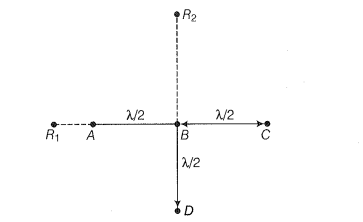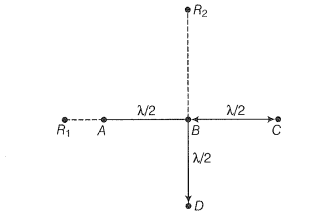Four identical monochromatic sources A, B, C, D as shown in the (figure) produce waves of the same wavelength , and are coherent. Two receivers, and , are at great but equal distances from B.
(i) Which of the two receivers picks up the larger signal?
(ii) Which of the two receivers picks up the larger signal when B is turned off?
(iii) Which of the two receivers picks up the larger signal when D is turned off?
(iv) Which of the two receivers can distinguish which of the sources B or D has been turned off?

Hint: The signal received by the two receivers depends on the phase of the signals.
Step 1: Find the signal received by .
(i) Consider the disturbances at the receiver which is at distance d from B.
Let the wave at , because of A be = cos . The path difference of the signal from A with that from B is and hence, the phase difference is .
Thus, the wave at , because of B is
The path difference of the signal from C with that from A is and hence the phase difference
is 2.
Thus, the wave at , because of C is

The path difference between the signal from D with that of A is;
Therefore, the phase difference is .
Thus, the signal picked up at from all four sources is
Step 2: Find the signal received by .
Let the signal picked up at from B be
The path difference between signal at D and that at B is .
The path difference between signal at A and that at B is
As d >> , therefore this path difference
and, phase difference =
Hence,
similarly,
The signal picked up by ,
Thus picks up the larger signal.
Step 3: Find the signal received by and when B is switched off.
(ii) lf B switched off,
picks up y=acos
Thus picks up the same signal.
Step 4: Find the signal received by and when D is switched off.
(iii) lf D is switched off,
picks up y=acos
(iv) Thus picks up a larger signal compared to indicated B has been switched off and an enhanced signal at indicated D has been switched off.

© 2025 GoodEd Technologies Pvt. Ltd.